The Guitarist’s Guide To Grunge: Essential bands, gear and players
It’s been three decades since grunge cracked the mainstream, but it remains one of the most important moments in the history of guitar music. In a new series, we examine the important bands, gear and players from this remarkable movement.
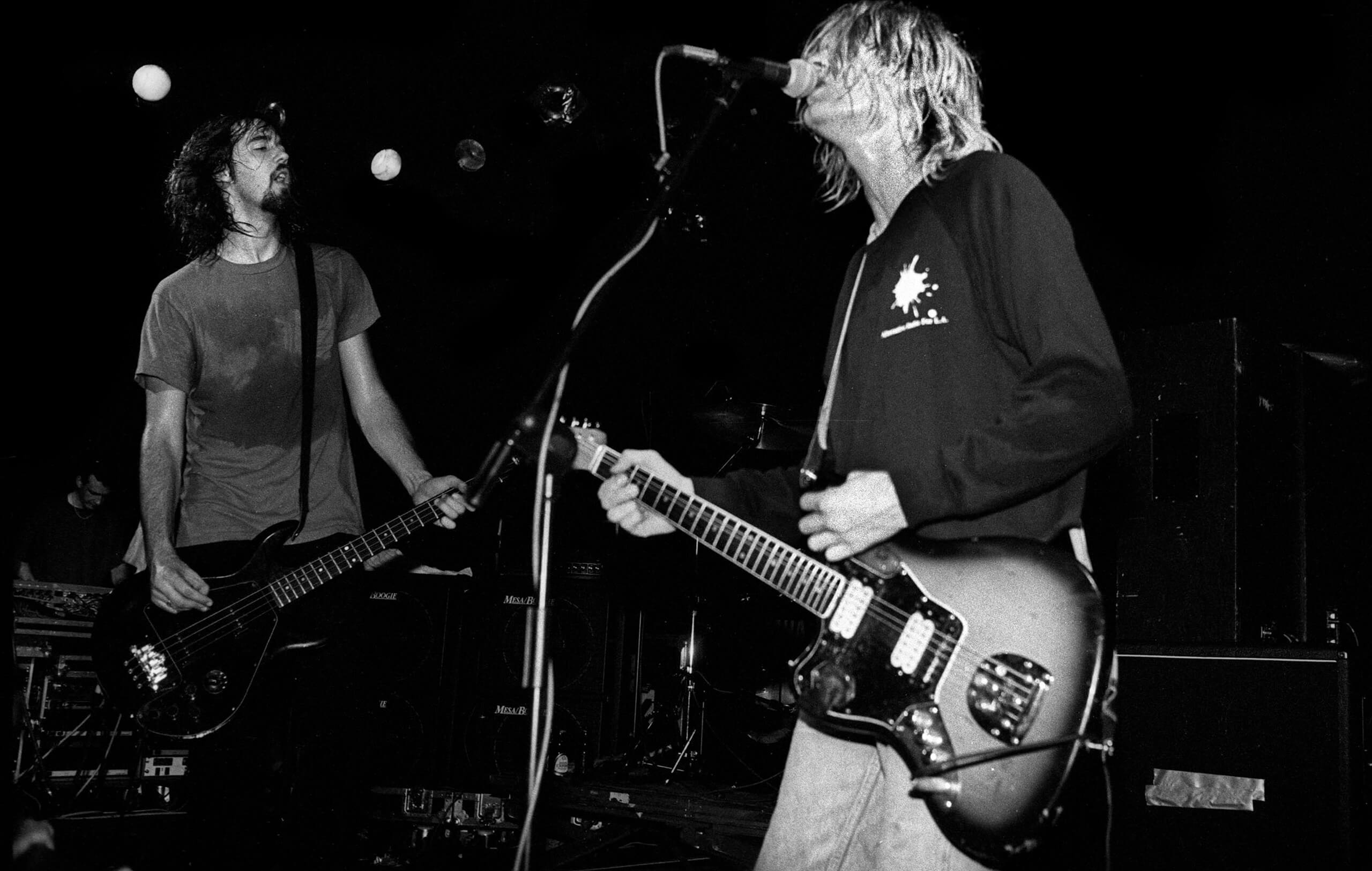
Image: Paul Bergen / Redferns / Getty Images
Editor’s note: Everyone at Guitar.com was deeply saddened by the passing of Michael Leonard in July 2021. Michael was a valued and much respected contributor to both Guitar Magazine and Guitar.com in the years since. We present Michael’s final article here so that we may all remember him doing what he did best – sharing his enthusiasm and knowledge of guitar music with the world.
If you want to feel old, remind yourself that 2021 marks 30 years since grunge went overground and, led by Nirvana, a score of revolutionary bands became household names and inspired millions to pick up guitar and play it in a way that was altogether more angular and noisy than what had come before. By way of comparison, go back 30 years from 1991 and the Beatles had yet to sign a record deal, the Stones hadn’t even formed, and Britain’s biggest guitar hero was Hank Marvin. Talk about “too much fucking perspective”…
But even with so much distance between now and then, grunge remains a truly important and significant moment in the history of our instrument. Britpop’s shenanigans might have led to an epidemic of young men in Adidas Gazelles reaching for Sheratons, but it famously never really exported beyond these shores. There’s an argument therefore that grunge was the last truly global phenomenon in guitar culture.
Grunge changed music, fashion, guitar aesthetics, gear trends… all of which reverberate to this day. Check out how many bright young things in 2021 are pulled to the offset guitars that grunge guitarists used primarily because at the time they were unpopular enough to offer excellent bang for buck. It didn’t arrive out of nowhere, of course, and change from the 80s predominant trends – be it hair metal, winsome indie or slick virtuoso twiddling – had been coming for a while. But no one perhaps expected such a shift for the new so-called Generation X.
But in our enthusiasm to canonise, and in some cases pigeonhole a genre, it’s all too easy to focus on the big bands and forget that another important facet of grunge was its diversity. It was a ‘movement’ of often strange bedfellows united by little more than geography or the desire to do something different with guitar than what had gone before. Even if only a select few would become megastars, all had their impact on what would come afterward, leading to a family tree that stretches further and wider than anyone could have anticipated.
Many of those bands – and sadly, some band-members – have since left us but forgive us some nostalgia as we revisit the artists, records and instruments that saw grunge, 30 years ago, in bloom…
Mudhoney
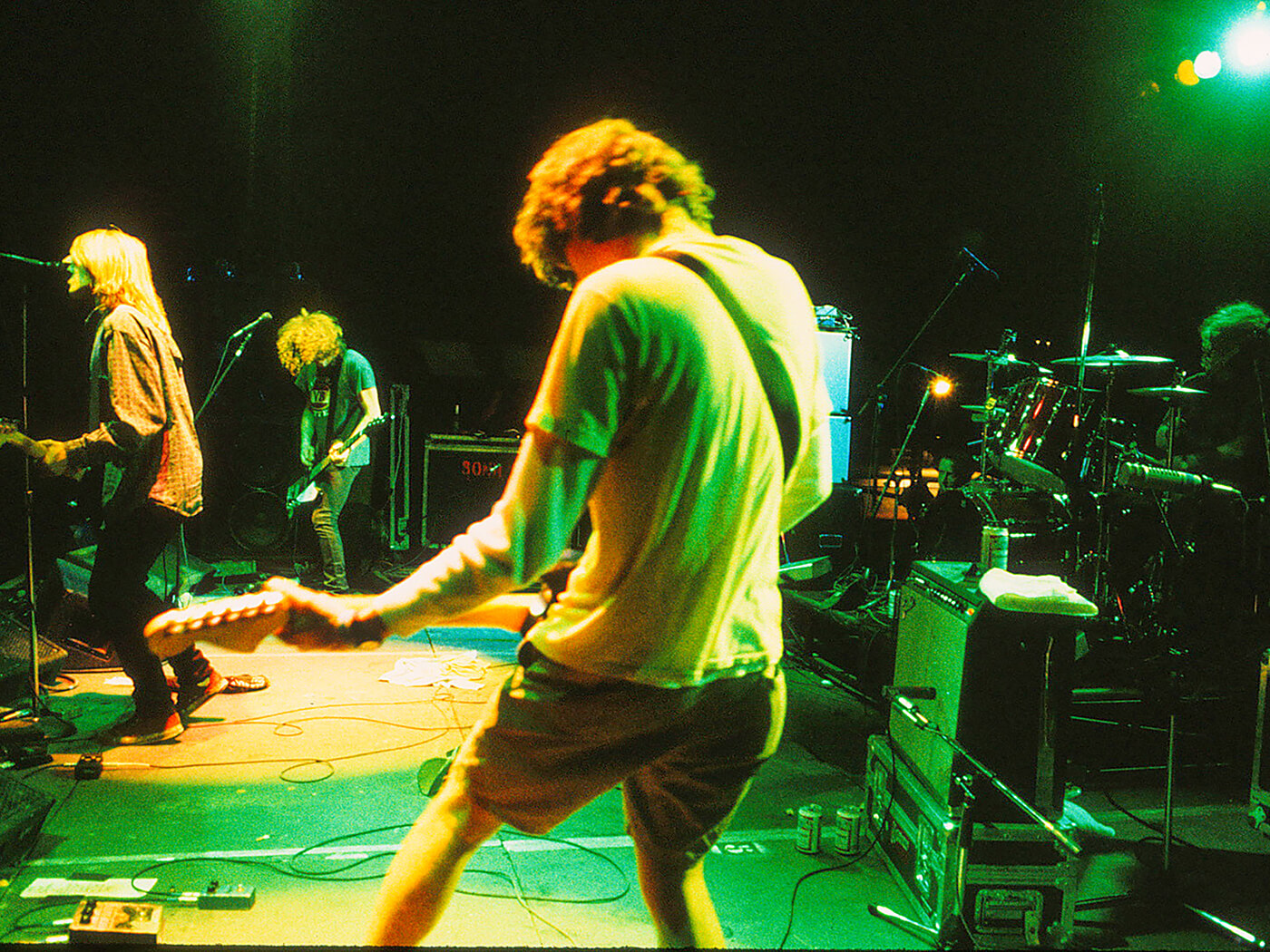
There’s an argument that Mudhoney are the true unsung heroes of grunge, the flannel brigade’s prophets without honour. They were name-checked by many of their Seattle peers from the start – Kurt Cobain was particularly enthusiastic – but the reality of their ongoing career is that they’ve only ever had one album even chart in the US’s Billboard 200. Yet they were trailblazers.
Mark Arm (vox/guitar) and Steve Turner (lead guitar) formed Mudhoney from the ashes of another cult punk outfit, Green River (who also featured Pearl Jam’s Stone Gossard and Jeff Ament). Drummer Dan Peters would briefly moonlight for Nirvana, pre Dave Grohl. Mudhoney’s early photographer was a just-graduated Seattle local, Charles Peterson, future imager-in-chief for a slew of bands… Whenever there’s a discussion about grunge’s gnarly family tree, Mudhoney appear to be the trunk.
Mudhoney formed in 1988, releasing their debut single Touch Me I’m Sick just three months later. It was a two-and-a-half-minute Stooges-alike blast. “There’s something special about that first single, we were never quite able to recapture that sound,” Mark Arm later recalled. “I don’t know if it was the guitars or the recording. It was just a really gnarly, gnarly guitar sound. … I think it had more to do with the actual electromagnetic chemistry of what was going through our amps that day. It was just a cool, fried-out sound.
That “fried out” sound was down to an EHX Big Muff pedal maxed-out, and Mudhoney soon became synonymous with the art of fuzz. Following EP, Superfuzz BigMuff, was even named after their favourite stomps. Turner says the grunge aesthetic was: “Garage punk, and punk rock in general – a lot of it was made with cheap gear, and a lot of it was reclaiming gear that guitarists had kind of dismissed as garbage. Like the [Fender] Mustang. That was my ultimate guitar back when I was a kid, but it was pooh-poohed when I finally got one. I could get them for $150.” You can keep your Floyd Rose locking trems and scalloped fretboards, Mr Widdle… a new/old way of thinking had begun.
Essential Listening
- Superfuzz Bigmuff EP (1988)
- Every Good Boy Deserves Fudge (1991)
Key Gear (current)
Mark Arm
Steve Turner
- 1960s Guild Starfire IVs
- 1970s Fender ‘Competition’ Mustang
- EHX Nano Big Muff Pi
- Foxx Tone Machine
Dinosaur Jr
Joseph ‘J’ Mascis’s ‘offhand-slacker’ persona occasionally had him painted as something of a wastrel in the media, but that is so wrong. From DJr’s breakthrough 1988 Bug album (with stone classic 7-inch Freak Scene) through the 90s, Mascis has proved himself an exceptional player who can rip screechingly discordant punk solos but also occasionally drop the melodic nous of one of his unlikely heroes, Deep Purple’s Ritchie Blackmore.
“When I play a solo I’m just expressing that moment,” Mascis says. “It can go horribly wrong easily enough. Some nights you can pull stuff off, other nights you can’t … but you don’t know until you try.” He’s also a crisp rhythm player. Over the years, Mascis has guested on records by Sonic Youth, Buffalo Tom, Gumball, Mike Watt, fIREHOSE, and many others, making him noise rock’s big hairy Zelig. In more recent years, he’s increasingly turned to acoustic music… and he nails that too, being an impressively adept fingerpicker. Legend.
Essential Listening
- Bug (1988),
- Where You Been (1992)
- Martin & Me (1996) – J Mascis Solo
- Several Shades Of Why (2011)
Key Gear
- Fender Jazzmasters, Esquire
- Custom Shop Thinline Telecaster
- Gibson Les Paul Jrs (“the P-90 is my favourite pickup”)
- Gibson Hummingbird
- Martin D-28.
- EHX Big Muff Pi
- EHX Small Clone Chorus
- EHX Deluxe Memory Man
- Lovetone Big Cheese and Meatball
- Real McCoy Custom Wah… and loads more. Such is his effects obsession, he even has a mini-pedalboard he can even take as plane hand-luggage, packed with an Ibanez Analog Delay Mini, Mooer ElecLady Flanger, Keeley Red Dirt overdrive, D-Sound ’73 Ram’s Head Fuzz (and Wren & Cuff replica) and more
Sonic Youth

New York’s Sonic Youth weren’t a ‘grunge’ band, of course, but their influence lies heavy across the whole scene as a sodden Seattle autumn. They were the ostensible ‘stars’ of 1991: The Year Punk Broke – Dave Markey’s hugely important documentary that chronicled their 1991 European tour, and also featured Nirvana and Dinosaur Jr.
‘The Kids’ loved the Youth. Daydream Nation (1988) was where their avant garde stylings became more accessible, even if Teenage Riot was still in their trademark crazy tunings (Thurston Moore is in GABDEG, Lee Ranaldo is GGDDGG). But it’s a relatively straightforward rocker, celebrating a scenario of J Mascis being President of the USA (something that’s less absurd now than it was 30 years ago). Thurston Moore and Lee Ranaldo also did much for the rehabilitation of the Fender Jazzmaster in noise rock, and both went on to have their own signature models.
Essential Listening
- Daydream Nation (1988)
- Dirty (1992)
Key Gear
Thurston Moore
- Fender Jazzmasters, Jaguars, Mustangs
- EHX Sovtek Civil War Big Muff
- Pro-Co TurboRat
- MXR Phase 90
- MXR Blue Box fuzz
Lee Ranaldo
- Fender Jazzmasters
- Mustangs, Jaguars
- Telecaster Deluxe and Thinline
- Fender Electric XII
- Deimel Lee Ranaldo Custom 12-String
- MXR Blue Box M103
- Mutron Bi-Phase
Pearl Jam
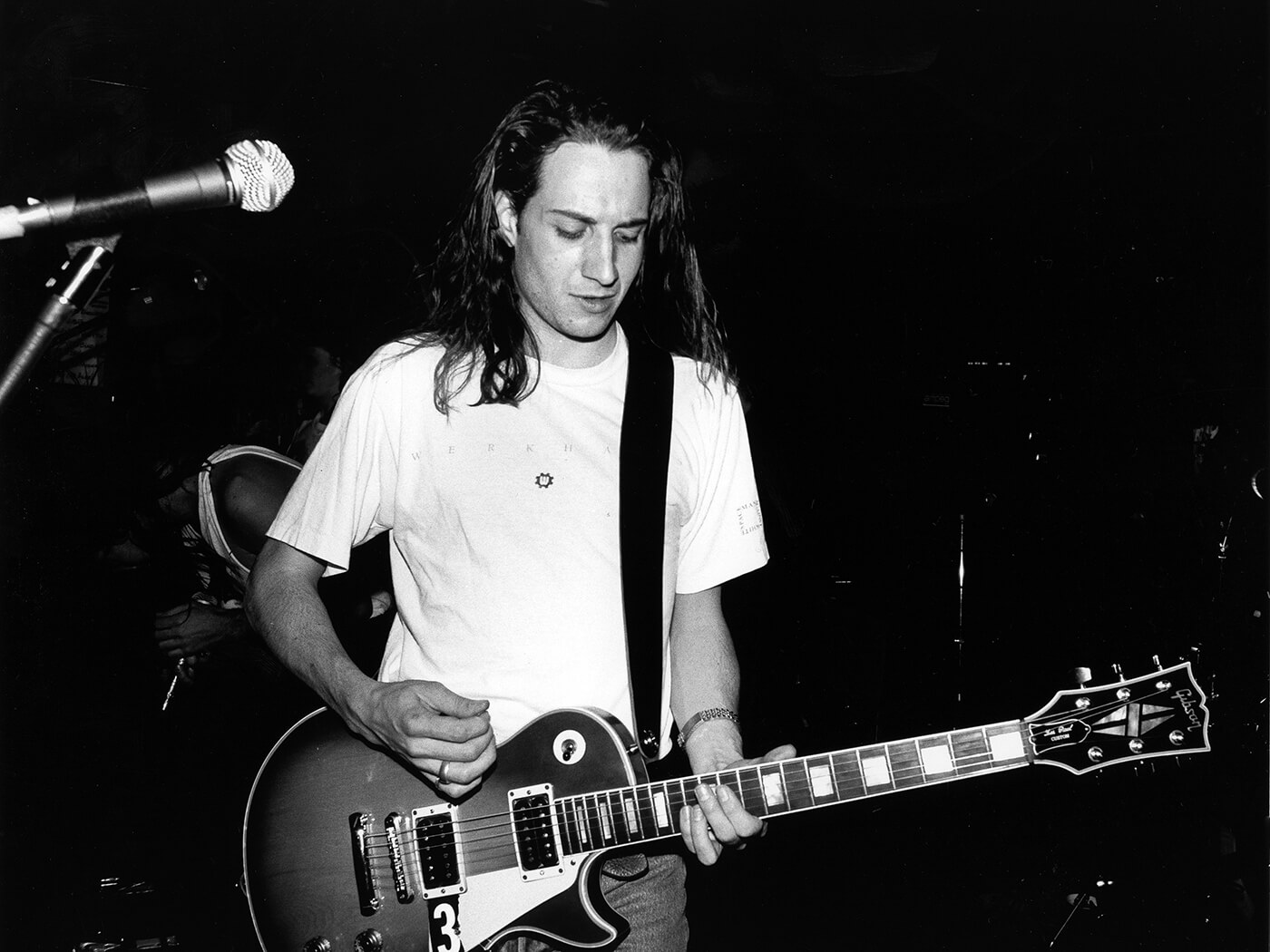
Of all the bands that broke big in 1991, Pearl Jam have been the most enduring. They’re survivors. Guitarist Stone Gossard and bassist Jeff Ament had been together before in proto-grungers Green River, Mother Love Bone and Temple Of The Dog, picking up alliances along the way. The Seattle scene was rife with collaborations in the late 80s, and while MLB’s Matt Cameron went off to Soundgarden temporarily, guitarist Mike McCready stayed around, and picking up vocalist/occasional collaborator Eddie Vedder, Pearl Jam was born. They only settled into solidity in 1990 but by the end of 1992, debut album Ten (released in August 1991) meant PJ had become one of America’s biggest rock bands. They haven’t budged since.
- READ MORE: Pearl Jam’s best live guitar moments, ranked
Ten was almost grunge by numbers, lyrically, with dark subjects of depression, suicide, loneliness, and murder, but Pearl Jam’s sound was more traditionally ‘classic rock’ than some of their punkish peers which gave them a much broader appeal. Their anthemic, intentionally epic songs boast plenty of guitar soloing and a bizarre war of words soon broke out about Pearl Jam’s grunge ‘credibility’: one NME review said that Pearl Jam were “trying to steal money from young alternative kids’ pockets” and Nirvana’s Kurt Cobain angrily attacked Pearl Jam, claiming the band were “commercial sellouts” (the two reconciled before Cobain’s death). But the fans didn’t even care: Even Flow, Jeremy, Alive, Daughter, Spin The Black Circle… bruising hits flowed in the early years and album sales and tours were huge.
Gossard and McCready were never punk iconoclasts, in truth. Gossard tends to be the riffman, tuning to open D, but McCready’s a quite traditional lead player. “We’re pretty opposite as players, so we complement one another,” says Gossard. “It’s a trade-off between us. You’ll hear Mike’s guitar come up for the solos, but there are a lot of songs where my rhythm parts are playing the main riff.”
McCready admitted early on to being a huge SRV and KISS fan, which wouldn’t cut the mustard in Mudhoney. But impressively, they’ve stayed a solid unit. Coming out of a scene too-often characterised by splits, troughs and deaths, any 30-plus year career is tough to argue with. They keep fans onside with activism and a steady supply of ‘official’ bootlegs. An even flow, indeed.
Essential listening
- Ten (1991)
- Vitology (1994)
- Pearl Jam (2006)
Key Gear
Stone Gossard
- 50s, 60s, 70s Gibson Les Pauls.
- 1950s Fender Stratocasters,
- Various 1960s Gibson ES-33x models
- Dunlop Wah Pedal
- MXR Super Comp and Phase 90
- Ibanez Tube Screamer
- … lots of traditional vintage gear!
Mike McCready
- 1950s Fender Strats and Teles
- 1959/60 Gibson Les Paul Reissues
- Original 1956 Les Paul (black) and 59 (burst), and more
- MXR wah, Phase 90 and Carbon Copy Delay
- Ibanez Tube Screamer
- Way Huge Green Rhino Overdrive
- Pearl Jam are more boutique dealer than thrift shop
Soundgarden
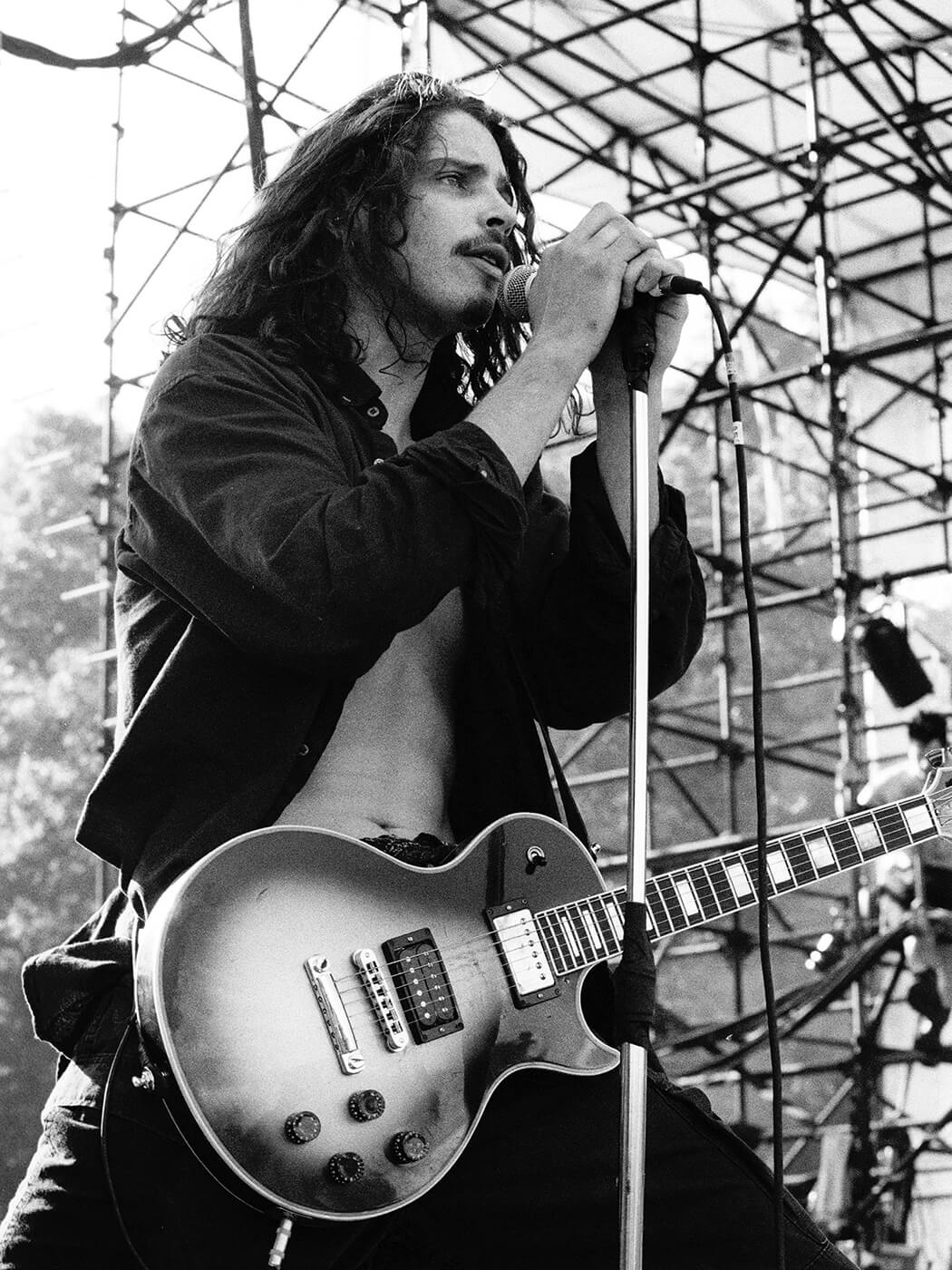
It may be a surprise, but Soundgarden were the first grunge Seattle-ites to score a major record deal, signing to A&M in 1989. Guitarist/frontman Chris Cornell and ‘colour guitar’ player Kim Thayil (he prefers that term to ‘lead guitarist’) were the only constants in their 1984-2019 on/off career. It wasn’t until third album, Badmotorfinger (1991) that they really flew, though, with Jesus Christ Pose and Rusty Cage earning equal parts fame and notoriety.
Although forever in the shadows of Nirvana and Pearl Jam in commercial terms, Soundgarden were perhaps the most ambitious band of the grunge era: Cornell’s bruising wail and Thayil’s use of Eastern drones and Beatles-esque psychedelic figures set them apart from any ‘punk’ roots or Iommi-esque doom riffing, as did their songs’ rhythmic complexity and almost progressive rock style interludes. Soundgarden hit their zenith on 1994’s Superunknown, a sprawling 70-minute epic that’s more redolent of mid-70s Led Zep grandiosity than punk night in a Washington dive bar: Black Hole Sun, Spoonman, The Day I Tried To Live, Fell On Black Days… this was PhD-level ‘grunge’.
Cornell may have been the primary writer, but it was Thayil’s guitars which gave Soundgarden their instrumental identity. “I push the band to be heavy and dark – that’s always been my role,” he said in 2012. “The complex, cascading, complementary dark layers you can create are often heavier than the visceral approach. I think anything different or mysterious can be channelled into heavy – abnormality is a key.”
Essential listening
- Badmotorfinger (1991)
- Superunknown (1994)
- Down On The Upside (1996)
Key Gear
Chris Cornell
- Gibson ES-335s (including, now, the Tribute model)
- Various Gibson Les Pauls, Gretsch Duo-Jets
- Kim Thayil – Guild S-100 and S-300s (“the neck is faster than the standard Gibson SG necks”)
- Gibson Firebird
- Fender Telecaster
- Hughes & Kettner Tube Rotosphere
- MXR wah and MC-402 Distortion/Overdrive
- EHX POG octave pedal
- BOSS CS-9 chorus and DD-7 delay
Smashing Pumpkins
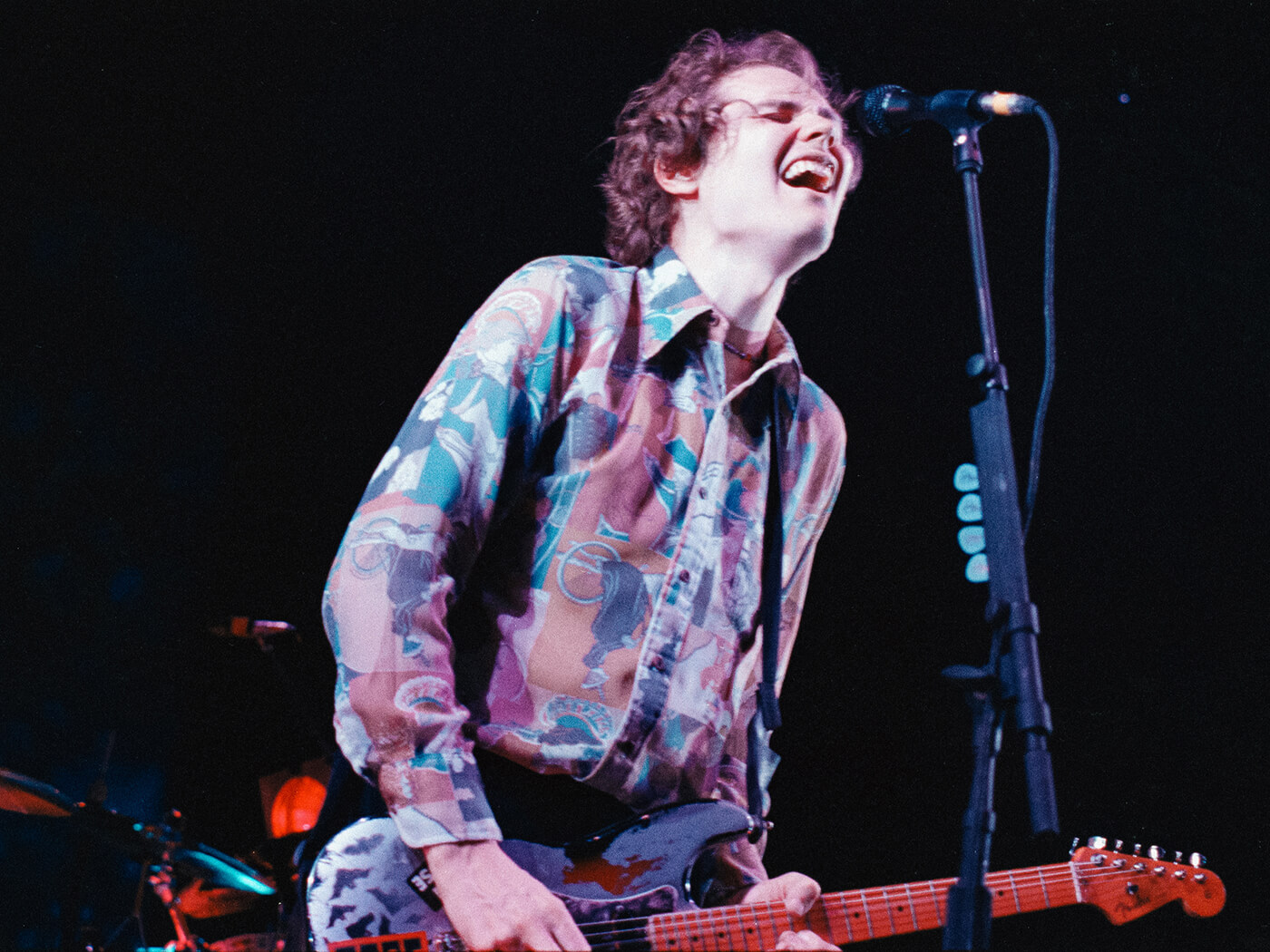
Like Pearl Jam and Soundgarden, Smashing Pumpkins only really sounded grunge during the era’s first flush. Gish (1991) arrived before Nevermind and was similarly produced by Butch Vig armed with a blitzkrieg of guitar riffing bolstering the fear and self-loathing. But by Siamese Dream (1993), it was clear the Pumpkins had loftier theatrical ambitions. Billy Corgan could orchestrate guitars like Brian May and pummel riffs like Jimmy Page. He was also very much in charge: James Iha (guitars) and D’Arcy Wretzky (bass) barely played on Siamese Dream at all, it was all Corgan.
From here, it was a short hop to the full-on grandiosity of double LP Mellon Collie & The Infinite Sadness (1996) which, frankly, is about as punk rock as Physical Graffiti. Corgan was an opposite of Kurt Cobain in many ways, not concerned with pop accessibility, and very much taking pride in his technical prowess: “We can mow any band down right now,” he told Guitar on Mellon Collie…’s release). Predominantly synth-led latest album Cyr evinces how Corgan was always looking to New Order and The Cure as much as Black Sabbath, but what a guitar sound early on: Corgan credits much of it to his KT-88 tube modded ‘Soul Head’ Marshall JCM800 2203.
Essential Listening
- Gish (1991)
- Siamese Dream (1993)
- Mellon Collie & The Infinite Sadness (1996)
Key Gear
Billy Corgan
- Fender Mustang, hardtail 1970s Fender Strats, early 90s silver Fender Stratocaster,
- Gibson ES-335s, and in more recent years various Reverend and Yamaha acoustic signatures.
- The outspoken Corgan says he’ll never work with Fender again or Gibson because they “disrespected” him.
- 1970S Electro-Harmonix Op-Amp Big Muff, MXR Phase 90s and Phase 100s,
- EHX Bad Stone Maestro PS-1A and (importantly) a Mu-Tron Bi-Phase
Nirvana
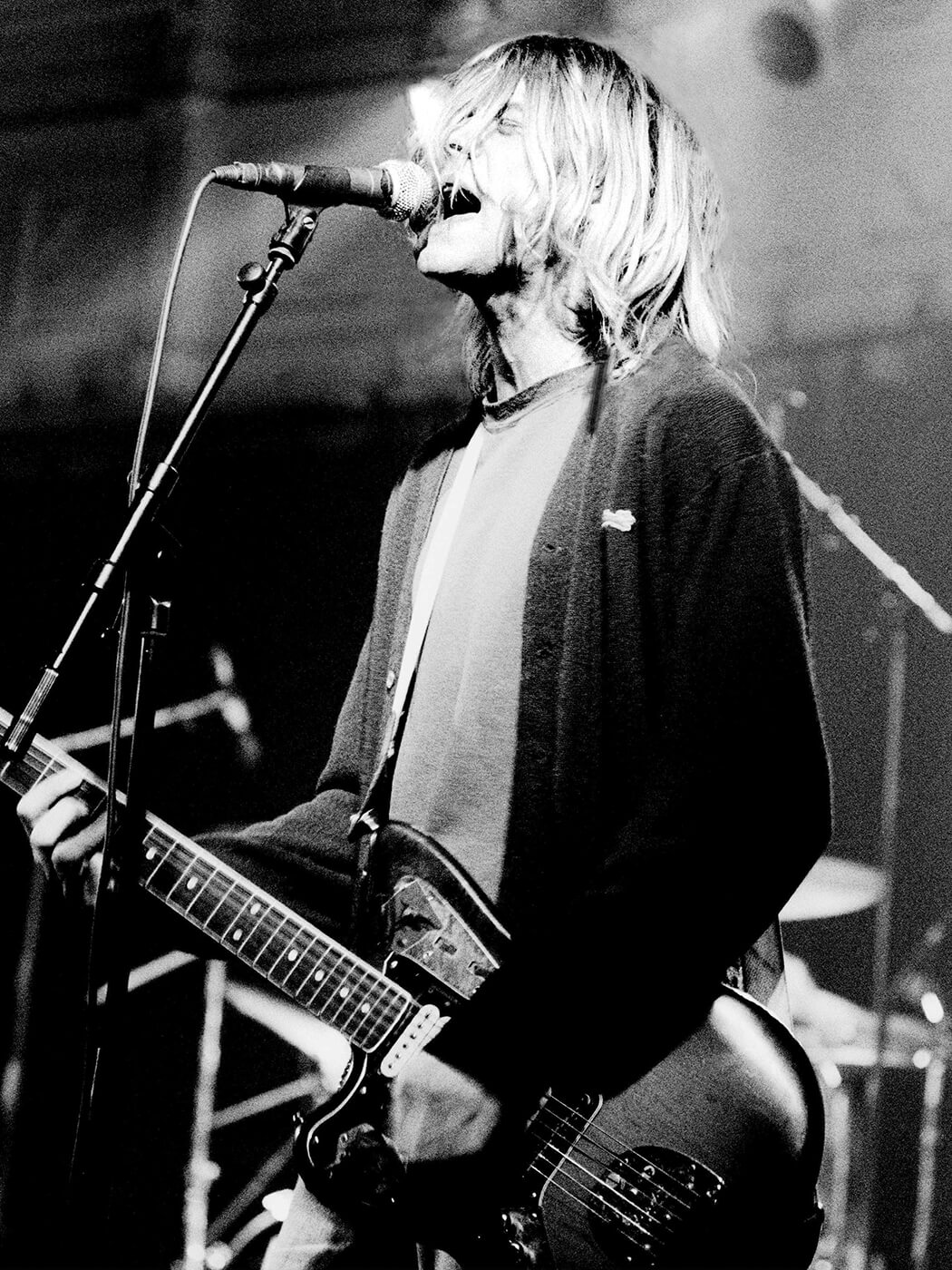
Without question, Nirvana were the most influential of all the grunge era bands. Part of it might be sad circumstance (they never really had time to make a big mistake), but they did also possess something special.
Like many of their peers, they got the first break via the Sub Pop label (with ‘88’s cover of Shocking Blue’s Love Buzz), which led to the $450 recording of debut album Bleach the following year. It was patchy, and they weren’t exactly hailed as the world’s most influential band-in-waiting and a recently discovered uncashed royalty cheque for Kurt Cobain in 1990 totalled a meagre $26.57: even if monthly, that’s no living.
But two songs pointed upwards: a punk blast called Negative Creep and a Beatles-esque slice of pop called About A Girl. David Geffen’s DGC were impressed enough to sign them. The story of Nevermind (1991) is well-trodden: how Geffen weren’t particularly happy with the band’s choice of the relatively-inexperienced Butch Vig as producer, hence the hiring of (Slayer producer) Andy Wallace to add a mix sheen. The budget was upped to a lofty $500,000.
The resulting LP, originally to be called Sheep, was led by a Smoke On The Water / More Than A Feeling of its day in Smells Like Teen Spirit and everyone initially seemed happy. Cobain had been aiming at a more accessible pop sound… and it was only in 1993 that he complained, “Looking back on the production of Nevermind, I’m embarrassed by it now. It’s closer to a Mötley Crüe record than it is a punk rock record.”
The reaction was the scabrous Steve Albini-produced In Utero (1993), perhaps the finest representation of the band’s oeuvre, even if DGC were reportedly horrified and understandably so: it sold half of what Nevermind did. And that, posthumously-released Unplugged album and live sets/outakes aside, was it. Cobain said his plan for the fourth Nirvana studio LP was “pretty ethereal, acoustic, like REM’s last album.” There were suggestions it might even mean a solo career without the baggage of the G word. Cobain knew very well about the vagaries of pop stardom and labels.
“Grunge is as potent a term as new wave,” Cobain told Rolling Stone in January 1994. “You can’t get out of it. It’s going to be passé.” He was wrong about that, but he was wrong about many things… In the very same interview (three months before he took his own life) he insisted, “I’ve never been happier in my life.”

Even after all this time, Cobain remains a somewhat controversial figure in guitar culture. In his final interview, with Fender’s Frontlines magazine, he was asked what he felt when it was time to “cut loose” on the guitar and he bluntly answered: “Less than you could possibly imagine.” In the mid-90s, as a new Foo Fighter, Dave Grohl told Guitar: “Kurt never had any interest in improving his guitar playing in a technical sense. But when it was time for him to do something, it was unlike anything that anyone had ever done.” Cobain did say he’d taken guitar lessons for a week when 14, saying he learned AC/DC’s Back In Black. But soon he was just writing his own songs. “Once you know the power chord, you don’t need to learn anything else.” It’s telling that two famous Cobain ‘solos’ – …Teen Spirit and Come As You Are – essentially ape the vocal melody.
Cobain’s mastery, or otherwise, of the guitar is irrelevant. Nirvana’s influence was much deeper and wider than technicality. They effectively made alt-rock a saleable commodity and angst a currency. Cobain, by his sheer popularity, made cheap ‘student’ guitars desirable. His naivety was a beacon to any guitarist struggling to play ‘properly.’ Before Nevermind, grunge was regional rock music: afterwards, it was global phenomenon. By the end of their brief stardom, there probably wasn’t a single guitar player who didn’t have a strong opinion on Nirvana. And that is influence.
Essential Listening
- Nevermind (1991)
- In Utero (1993)
- MTV Unplugged In New York (1995)
Key Gear
- Univox Hiflyer
- Epiphone ET270 (Bleach era)
- 1960s Fender Mustang
- Fender Jaguar with DiMarzio pickups
- Japanese Fender Strats (Nevermind and In Utero)
- Boss DS-2 distortion
- EHX Small Clone, Polychorus, Echoflanger and Big Muff
- Pro-Co RAT
Alice In Chains
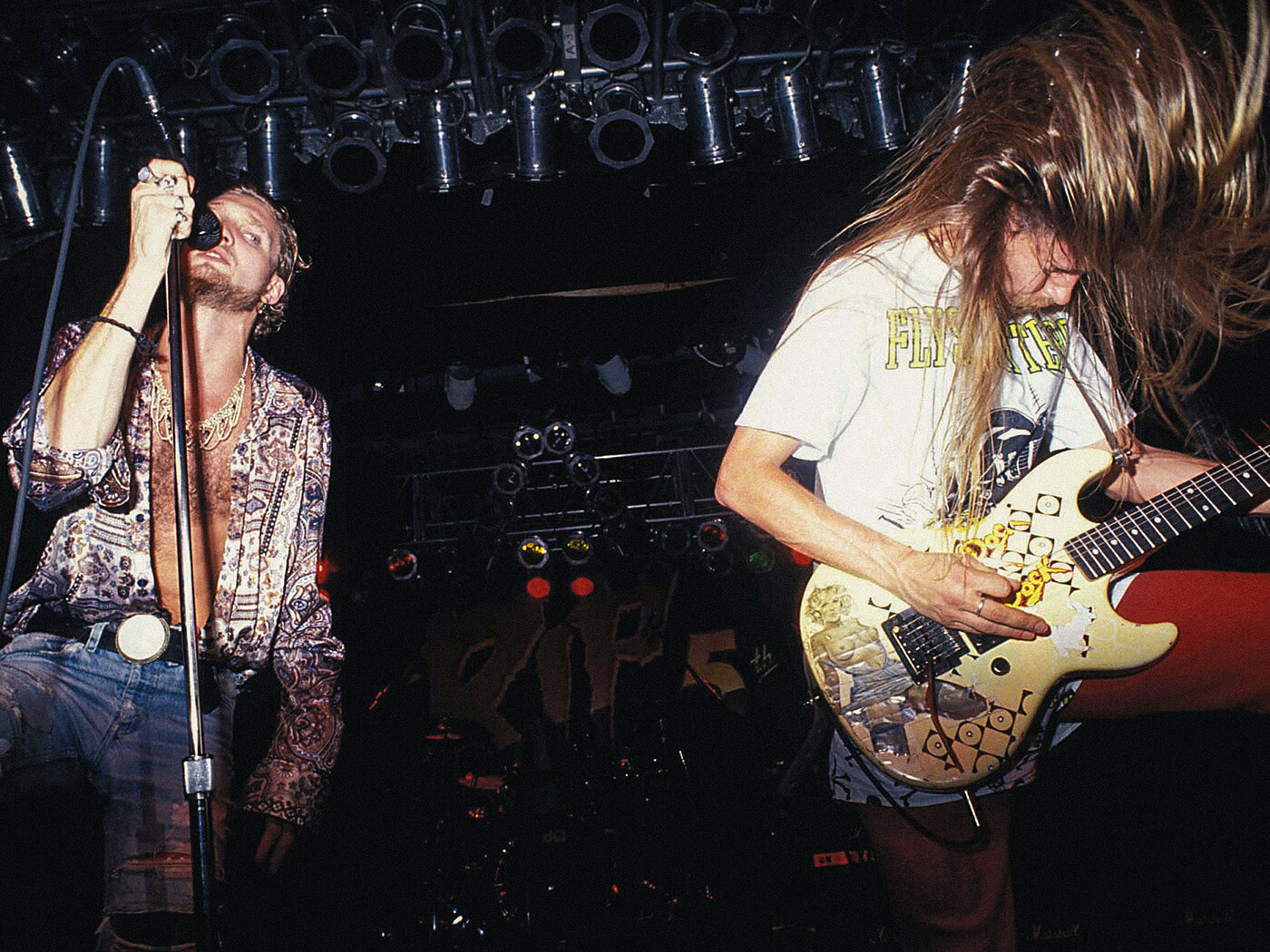
Alice In Chains are different again. While many of the grunge-era bands had a punk sensibility and were wholly dismissive of 80s glam and hair metal, AIC actually grew from that 80s scene. Guitarist Jerry Cantrell was previously in metal bands Diamond Lie and Gypsy Rose, Layne Staley was serving his apprenticeship in Seattle glamsters Sleze and the occasional funk-metal band – you can almost hear the leather trousers.
AIC couldn’t be accused of bandwagon jumping, though: their debut album Facelift (1990) was one of the first of the Seattle scene’s real hits, becoming ‘grunge’s first Gold record. Their metal tendencies served them well in terms of audience and airplay, they were virtuosic enough for metalheads, earning supports for Van Halen, Poison and Extreme, and sludgy enough for the grunge kids, and Man In The Box became an MTV staple. Second album Dirt (1992) was the big hitter, and anything but ‘party-on dudes’ metal. Six of the LP’s songs dealt with addiction, reflecting the whole band’s troubles (though particularly Layne Stayley’s long-running battle with heroin).
“We did a lot of soul searching on this album,” Cantrell admitted. “We deal with our daily demons through music. All of the poison that builds up during the day we cleanse when we play.” The gloom didn’t stop Would?, Rooster, Them Bones, Angry Chair, and Down In A Hole all becoming hits. AIC also arguably paved the way for a more nuanced grunge future, releasing the predominantly acoustic Sap (1992) and Jar Of Flies (1994) EPs.
Cantrell rarely cited punk as an influence: he’s claimed his biggest six-string heroes are Davey Johnstone (of Elton John’s band), Lindsey Buckingham and Billy Gibbons, and blues and country licks feature heavily on his solo albums. He says himself the band are “metal, blues, rock’n’roll, maybe a touch of punk. The metal part will never leave, and I never want it to.” He tunes to E♭, though that’s pretty common across genres, and although he’s not a ‘schooled’ musician, his choice of a G&L Rampages with Kahler vibratos was much more ‘metal’ than your usual grunge player. In 2010, Slash hailed Cantrell as “one of the most inspiring” lead guitar players of the last 20 years.
Essential Listening
- Dirt (1992)
- Jar Of Flies (1994)
Key Gear
- G&L Rampages with Kahler vibratos
- Gibson Les Paul, Gibson SG
- Dunlop Jerry Cantrell signature Cry Baby wah
- MXR EVH117 Flanger and Bass Octave Deluxe
- Eventide TimeFactor
- Boss CH-1 and CE-3 chorus pedals
- Ibanez TS808 Tube Screamer




